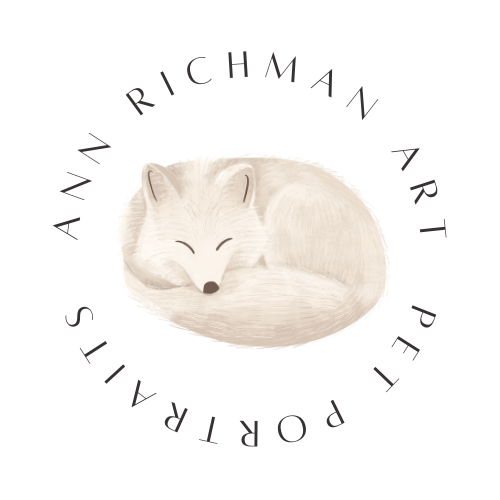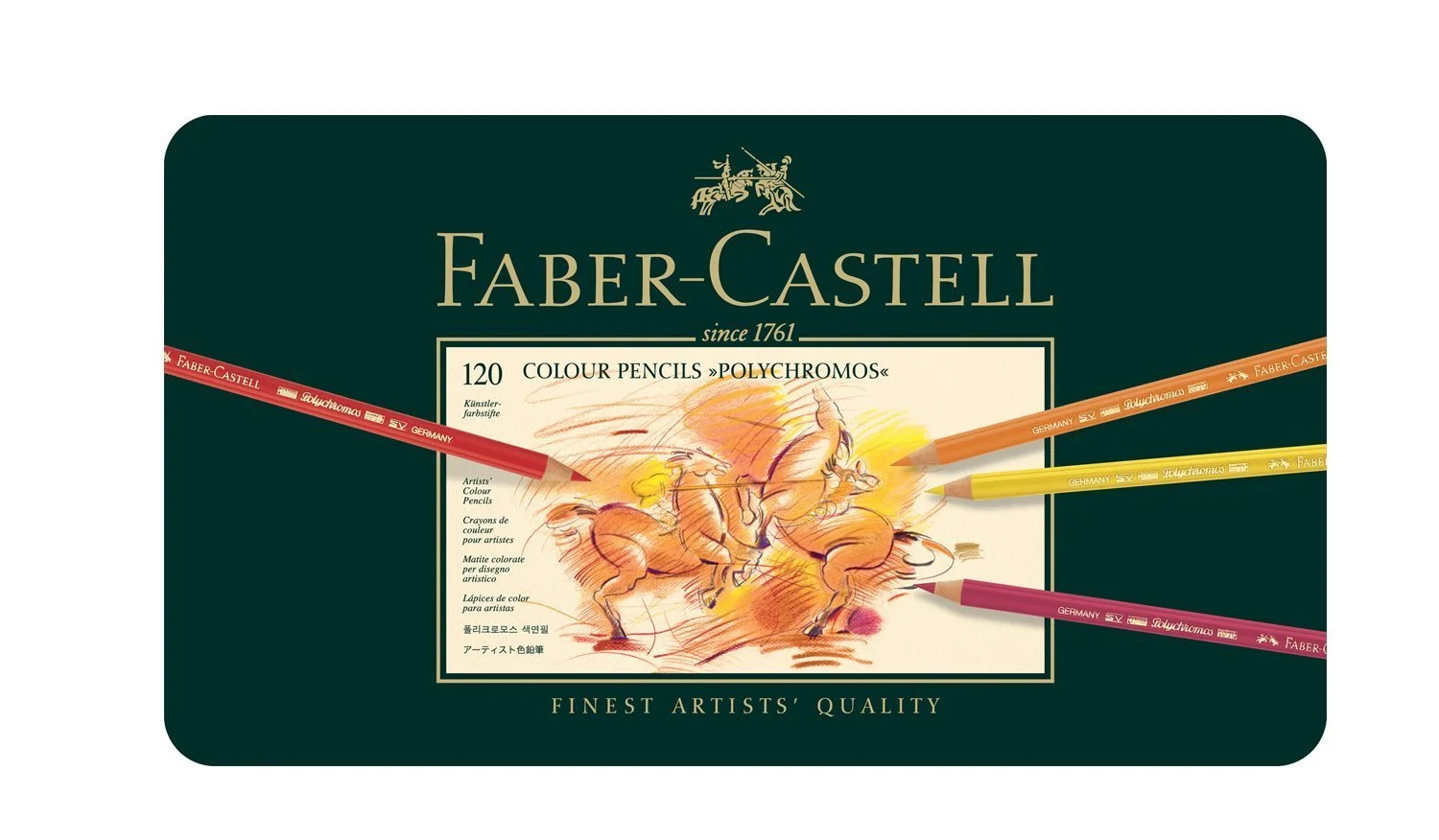Should I Use Wax or Oil-Based Colored Pencils?
Part 2- Oil-Based Pencils
Faber-Castell Polychromos are oil-based colored pencils.
If You Missed Part 1- Wax-based Pencils
Last week I went into the components of all colored pencils and the pros and cons of wax-based pencils. Make sure to check that out if you missed it here.
Oil-Based Pencils
As I mentioned in my previous post, I was primarily a wax-based Prismacolor Premier girl for the first few years that I was creating with colored pencils. I was introduced to oil-based pencils when I followed some tutorials by a colored pencil artist, Leontine Van Vliet (who is amazing, by the way). I am so glad she opened my eyes to these pencils. Oil-based pencils have amazing properties, and I think I was just scared to try them initially. But there was no reason to fear. They are very similar to wax-based pencils but can be used to create different effects.
The most common types of oil-based pencils are Faber-Castell Polychromos. Caran D’Ache also has an excellent line called Pablos. I bought several single pencils of varying colors, and I would love to buy the whole set of Pablos. They are very much like the Polychromos pencils but come in different colors. Also, Derwent Lightfast colored pencils are oil-based. I have some of these, but I haven’t used them much so far, and I can’t speak with authority on their effectiveness. I have heard, though, that they don’t play well with others. Meaning, if you like to mix your pencil brands when you create a piece, then the Derwents might make it difficult for you. I did run into this with my last commission. I found they wouldn’t lay overtop of my Polychromos very well.
Okay, let’s discuss the good things about oil-based pencils.
Positives of Oil-Based Pencils
“Ruby”, by Ann Richman, completed with Faber-Castell Polychromos pencils.
You Can Use Oil-Based Pencils For Many Techniques
Much like wax-based pencils, oil-based pencils will cover the tooth of the paper either by layering, burnishing, using solvents, or a combination of these techniques. I’ll also add to oil-based pencils the technique of blending with a paintbrush, Q-tip, or blending stump. You cannot do this with wax-based pencils because they “stick” on the paper more than oil-based pencils do.
Layering
I find that layering is easier to do with oil-based colored pencils. They are more translucent (see-through) than wax-based pencils which allow for color to shine through the bottom layers. This is very helpful for many applications, but especially for the eyes. You can highlight the many colors in a subject’s eyes using oil-based pencils. As you add layers on top of colors, the result is that you can still see some of the colors beneath. See below the drawing of “Snow Fox” for another example of this. You can see a lot of color in the fox’s eyes and in his fur. I drew him on Clairefontaine Pastelmat, which also allowed me to add all sorts of layers.
Oil-based pencils are harder than wax-based pencils. This allows for an even distribution of layers. I think it also enables you to put down lighter layers, especially if you are working on something like Clairefontaine Pastelmat or drafting film. It only requires a light touch to lay down a uniform layer.
Burnishing
Burnishing is a bit different when using oil-based pencils. I often use a lighter color oil-based pencil like a Warm Gray 1 Polychromos to burnish over top of layers in much the same way that I would with a lighter-colored Prismacolor pencil. But the result is a little different. When you burnish with an oil-based pencil you don’t need to squish the tooth of the paper to blend. The burnishing pencil is, in a sense, moving around the pigment on the paper, which mixes the layers and gets rid of the grain of the paper. It’s a softer type of burnishing than when using wax-based pencils.
Solvents
“They” (I guess I mean other artists) say that solvents work well with oil-based pencils. I admit I haven’t tried them with solvents so I don’t have an opinion on how well this works. I think oil-based pencils provide good coverage over the grain of the paper and so I don’t think you need to use solvents with them, especially if you use other tools like a blending stump. I am considering trying solvent with my next piece for the background. If I do that I’ll be sure to report back.
Blending
You can use tools to blend oil-based pencils when you really can’t do that with wax-based pencils. This is because the oil-based pigments don’t stick to the paper as well as the wax-based pigments. They are more powdery. As a result, you can use tools to move the pigment around. I like to use a paintbrush the most, but you could use a Q-tip or a blending stump as well. Tools such as these mix the colors and get rid of the grain of the paper.
“Snow Fox”, by Ann Richman. This fox was drawn with Polychromos and the background was rendered with pastels pencils.
2. Oil-Based Pencils Are More Affordable- Sort of
I would say the biggest bang for your buck with oil-based pencils is the 120 box of Faber-Castell Polychromos ($163). The color range is enough for you to be able to tackle any subject. Also, although the price is more than the bigger box (150) of the wax-based Prismacolor Premiers ($125), I can promise you that the Polychromos will last you way longer. Because they are harder, they keep their points a lot longer. Plus, they don’t break when you sharpen them. I have been frustrated with Prismas several times because while trying to sharpen one pencil, it would keep breaking until I had sharpened it way down the barrel. Not fun. Anyway, not so with the Polys! If you want a set of oil-based pencils I’d recommend Polychromos as your first set, for sure.
The Caran D’Ache Pablos pencils are my next-in-line purchase. But of course, being Caran D’Ache, they are much more expensive. They come in box sizes from 12 to 120 and range from $24 to $278. Keep in mind, these prices will vary widely based on supply and demand. The reason why these are next on my wish list is that they are very smooth like the Polychromos. I just happen to be a colored pencil pig, and I want more colors and pencils. It’s an addiction.
I mentioned that I have some Derwent Lightfast pencils. I have only bought single pencils when I thought the color might improve my collection. They do have some lovely rusty browns that I don’t see in the other sets. They come in boxes from 12 to 100 and cost $32 to $290.
3. Oil-based Pencils Work Well With Many Papers
Oil-based pencils work well on all of the same papers that wax-based pencils do. Those were colored pencil papers, hot press watercolor papers, drafting film, bristol smooth and vellum, and Clairefontaine pastelmat.
That said, I think the wax-based pencils work best on drafting film if you are using the extraction method (removing pigment with a sharp edge). That’s just because the wax pencils lay down in place better on drafting film and therefore can be removed easier.
Also, I would say that oil-based pencils excel on pastelmat. I actually prefer to use them on this surface because you can use tools to move the pigment around. Additionally, on any paper, you can erase oil-based pencils easier and remove pigment with tape to create textures, shapes, and remove mistakes. That’s a definite plus.
“Snow Leopard”, completed with Polychromos and the background with pastel pencils. Check out how much detail and color I was able to get in his eyes.
Negatives of Oil-Based Pencils
Saturated Look
You aren’t going to be able to get as saturated a look using oil-based pencils. I think the overall outcome just looks different than the wax-based pencils. This isn’t necessarily a negative. I’d say it depends on the outcome you are looking for. You can get a painterly look from either medium, but the wax-based pencils can create a more saturated look.
Smearing
Because I mentioned all of the good parts about how you can move the pigment around when using oil-based pencils, also be aware that they create more dust and smear very easily. Make sure that you keep something under your hand, like glycine paper, while you draw or you could make a mess. Also, whatever you do, don’t use a brush to wipe away pencil dust unless you want to see it smeared all over your paper.
Conclusion
Oil-based pencils are a lovely option to use. I’d say if you want to commit to either wax or oil-based as your first type of pencil, check out the pieces that artists are able to create and see what kind of pencil they are using. If you are drawn to a particular style, try that type of pencil first.
Have you already started drawing with colored pencils? If so, what was the first type that you used? I’d love to hear your thoughts.





